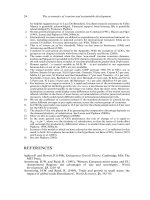THE ECONOMICS OF MONEY,BANKING, AND FINANCIAL MARKETS 375
Bạn đang xem bản rút gọn của tài liệu. Xem và tải ngay bản đầy đủ của tài liệu tại đây (34.45 KB, 1 trang )
CHAPTER 13
Banking and the Management of Financial Institutions
343
S U M M A RY
1. The balance sheet of commercial banks can be
thought of as a list of the sources and uses of bank
funds. The bank s liabilities are its sources of
funds, which include chequable deposits, time
deposits, advances from the Bank of Canada, borrowings from other banks and corporations, and
bank capital. The bank s assets are its uses of
funds, which include cash reserves, cash items in
process of collection, deposits at other banks,
securities, loans, and other assets (mostly physical
capital).
2. Banks make profits through the process of asset
transformation: they borrow short (accept deposits)
and lend long (make loans). When a bank takes in
additional deposits, it gains an equal amount of
reserves; when it pays out deposits, it loses an equal
amount of reserves.
3. Although more-liquid assets tend to earn lower
returns, banks still desire to hold them. Specifically,
banks hold reserves because they provide insurance
against the costs of a deposit outflow. Banks manage
their assets to maximize profits by seeking the highest
returns possible on loans and securities while at the
same time trying to lower risk and making adequate
provisions for liquidity. Although liability management was once a staid affair, large (money centre)
banks now actively seek out sources of funds by issuing liabilities such as negotiable CDs or by actively
borrowing from other banks and corporations. Banks
manage the amount of capital they hold to prevent
bank failure and to meet bank capital requirements
set by the regulatory authorities. However, they do
not want to hold too much capital because by so
doing they will lower the returns to equity holders.
4. The concepts of adverse selection and moral hazard
explain the origin of many credit risk management
principles involving loan activities, including screening and monitoring, development of long-term customer relationships, loan commitments, collateral,
compensating balances, and credit rationing.
5. With the increased volatility of interest rates that
occurred in recent years, financial institutions became
more concerned about their exposure to interest-rate
risk. Gap and duration analyses tell a financial institution if it has fewer rate-sensitive assets than liabilities
(in which case a rise in interest rates will reduce
income and a fall in interest rates will raise it) or more
rate-sensitive assets than liabilities (in which case a rise
in interest rates will raise income and a fall in interest
rates will reduce it). Financial institutions can manage
interest-rate risk by modifying their balance sheets and
by making use of new financial instruments.
6. Off-balance-sheet activities consist of trading financial
instruments and generating income from fees and loan
sales, all of which affect bank profits but are not visible on bank balance sheets. Because these offbalance-sheet activities expose banks to increased risk,
bank management must pay particular attention to risk
assessment procedures and internal controls to restrict
employees from taking on too much risk.
KEY TERMS
asset management,
balance sheet,
bank rate,
p. 321
p. 317
capital adequacy management,
p. 321
compensating balance,
p. 333
credit rationing, p. 333
credit risk,
p. 317
p. 336
equity multiplier (EM),
p. 324
banker s risk,
desired reserve ratio,
duration analysis,
p. 314
p. 322
p. 327
gap analysis (income gap analysis),
p. 334
loan sale,
p. 340
money centre banks, p. 326
overdraft loans (advances),
p. 316
reserves,
p. 317
return on assets (ROA),
p. 327
interest-rate risk, p. 322
return on equity (ROE),
p. 327
items in transit (bank float),
p. 317
secondary reserves, p. 317
T-account,
interbank deposits,
p. 317
deposit outflows,
p. 321
liability management,
desired reserves,
p. 317
liquidity management,
loan commitment,
p. 321
p. 321
p. 332
settlement balances,
p. 318
vault cash, p. 317
p. 316









